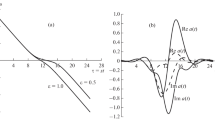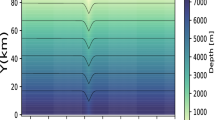Abstract
Large-scale zonal flow driven across submarine topography establishes standing Rossby waves. In the presence of stratification, the wave pattern can be represented by barotropic and baroclinic Rossby waves of mixed planetary topographic nature, which are locked to the topography. In the balance of momentum, the wave pattern manifests itself as topographic formstress. This wave-induced formstress has the net effect of braking the flow and reducing the zonal transport. Locally, it may lead to acceleration, and the parts induced by the barotropic and baroclinic waves may have opposing effects. This flow regime occurs in the circumpolar flow around Antarctica. The different roles that the wave-induced formstress plays in homogeneous and stratified flows through a zonal channel are analyzed with the BARBI (BARotropic-Baroclinic-Interaction ocean model, Olbers and Eden, J Phys Oceanogr 33:2719–2737, 2003) model. It is used in complete form and in a low-order version to clarify the different regimes. It is shown that the barotropic formstress arises by topographic locking due to viscous friction and the baroclinic one due to eddy-induced density advection. For the sinusoidal topography used in this study, the transport obeys a law in which friction and wave-induced formstress act as additive resistances, and windstress, the effect of Ekman pumping on the density stratification, and the buoyancy forcing (diapycnal mixing of the stratified water column) of the potential energy stored in the stratification act as additive forcing functions. The dependence of the resistance on the system parameters (lateral viscosity ε, lateral diffusivity κ of eddy density advection, Rossby radius λ, and topography height δ) as well as the dependence of transport on the forcing functions are determined. While the current intensity in a channel with homogeneous density decreases from the viscous flat bottom case in an inverse quadratic law ~δ –2 with increasing topography height and always depends on ε, a stratified system runs into a saturated state in which the transport becomes independent of δ and ε and is determined by the density diffusivity κ rather than the viscosity: κ/λ 2 acts as a vertical eddy viscosity, and the transport is λ 2/κ times the applied forcing. Critical values for the topographic heights in these regimes are identified.
Similar content being viewed by others
References
Borowski D (2003) The Antarctic Circumpolar Current: dynamics of a circumpolar channel with blocked geostrophic contours. PhD thesis, University Bremen
Borowski D, Gerdes R, Olbers D (2002) Thermohaline and wind forcing of a circumpolar channel with blocked geostrophic contours. J Phys Oceanogr 32:2520–2540
Bryan K, Cox MD (1972) The circulation of the world ocean: a numerical study. Part I, a homogeneous model. J Phys Oceanogr 2:319–335
Cai W, Baines PG (1996) Interactions between thermohaline- and wind-driven circulations and their relevance to the dynamics of the Antarctic Circumpolar Current, in a coarse-resolution global ocean general circulation model. J Geophys Res 101:14073–14094
Charney JG, DeVore JG (1979) Multiple flow equilibra in the atmosphere and blocking. J Atmos Sci 36:1205–1216
Cox MD (1975) A baroclinic numerical model of the world ocean: preliminary results. In: Numerical models of ocean circulation. Durham, New Hampshire, pp 107–120 (17–20 October 1972)
Gent PR, Large WG, Bryan FO (2001) What sets the mean transport through Drake Passage? J Geophys Res 106:2693–2712
Gnanadesikan A, Hallberg RW (2000) On the relationship of the circumpolar current to southern hemisphere winds in coarse resolution ocean models. J Phys Oceanogr 30:2013–2034
Krupitsky A, Cane MA (1994) On topographic pressure drag in a zonal channel. J Mar Res 52:1–23
MacCready P, Rhines PB (2001) Meridional transport across a zonal current: topographic localization. J Phys Oceanogr 31:1427–1439
Munk WH, Palmén E (1951) Note on dynamics of the Antarctic Circumpolar Current. Tellus 3:53–55
Olbers D, Eden C (2003) A simplified general circulation model for a baroclinic ocean with topography. Part I: theory, waves and wind-driven circulations. J Phys Oceanogr 33:2719–2737
Olbers D, Völker C (1996) Steady states and variability in oceanic zonal flows. In: Anderson DLT, Willebrand J (eds) Decadal climate variability dynamics and predicition. Springer, Berlin, pp 407–443
Olbers D, Borowski D, Völker C, Wolff J-O (2004) The dynamical balance, transport and circulation of the Antarctic circumpolar current. Antarctic Sci 16(4):439–470
Olbers D, Lettmann K, Timmermann R (2006) Six circumpolar currents—on the forcing of the Antarctic Circumpolar Current by wind and mixing. Ocean Dyn 57:12–31
Olbers DJ, Wenzel M, Willebrand J (1985) The inference of North Atlantic circulation patterns from climatological hydrographic data. Rev Geophys 23(4):313–356
Rhines P (1977) The dynamics of unsteady currents. In: Goldberg E (ed) The sea, vol VI. Wiley, New York, pp 189–318
Rhines PB, Young WR (1982) A theory of the wind-driven circulation. I. Mid-ocean gyres. J Mar Res 40(Suppl):559–596
Rintoul SR, Hughes C, Olbers D (2001) The Antarctic circumpolar current system. In: Siedler G, Church J, Gould J (eds) Ocean circulation and climate. Academic, New York, pp 271–302
Sarkisyan AS, Ivanov VF (1971) Joint effect of baroclinicity and bottom relief as an important factor in the dynamics of sea currents. Akad Nauk Atmosph Oceanic Phys 7(2):173–188
Stommel H (1957) A survey of ocean current theory. Deep Sea Res 4:149–184
Tansley CE, Marshall DP (2001) On the dynamics of wind-driven circumpolar currents. J Phys Oceanogr 31:3258–3273
Völker C (1999) Momentum balance in zonal flows and resonance of baroclinic Rossby waves. J Phys Oceanogr 29:1666–1681
Walsteijn F (1996) Numerical methods for quasigeostrophic turbulence. With application to the Antarctic circumpolar current. Technical report, Institute for Marine and Atmospheric Research, Utrecht, R96-12
Wang L, Huang RX (1995) A linear homogeneous model of wind-driven circulation in a β-plane channel. J Phys Oceanogr 25:587–603
Wolff J-O, Maier-Reimer E, Legutke S (1997) The Hamburg ocean primitive equation model. Technical report no. 13. In: Modell Betreuungsgruppe (ed) ISSN 0940-9327. Technical report, German climate computer center (DKRZ)
Author information
Authors and Affiliations
Corresponding author
Additional information
Responsible editor: Richard Greatbatch
Rights and permissions
About this article
Cite this article
Olbers, D., Lettmann, K. & Wolff, JO. Wave-induced topographic formstress in baroclinic channel flow. Ocean Dynamics 57, 511–530 (2007). https://doi.org/10.1007/s10236-007-0109-2
Received:
Accepted:
Published:
Issue Date:
DOI: https://doi.org/10.1007/s10236-007-0109-2




